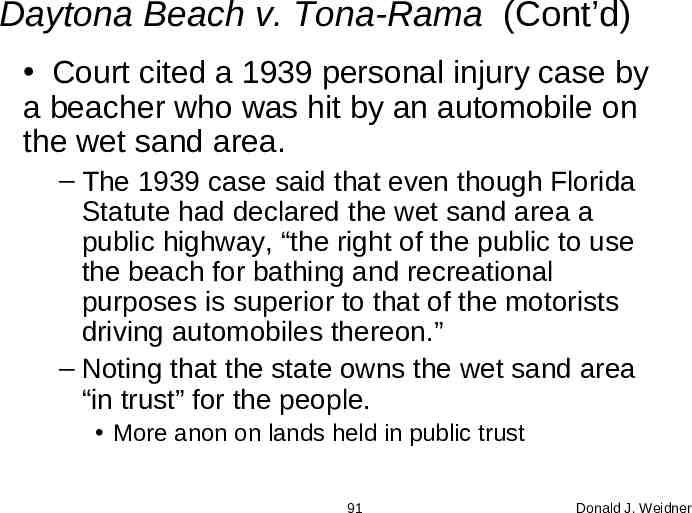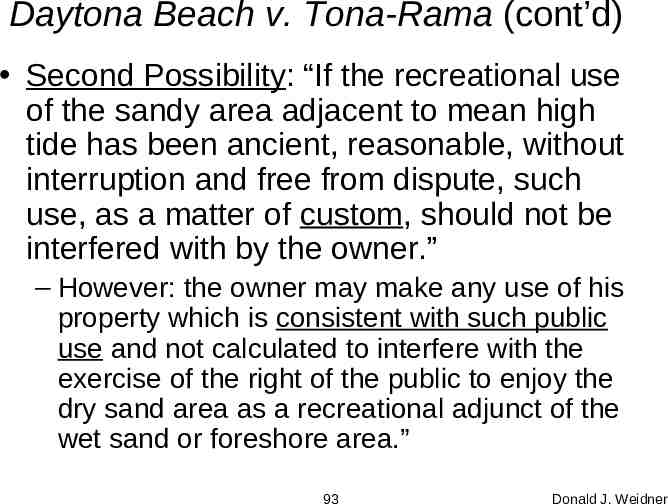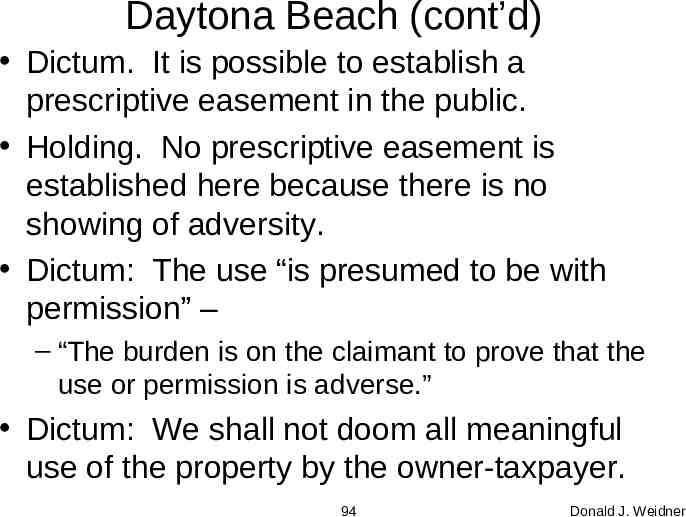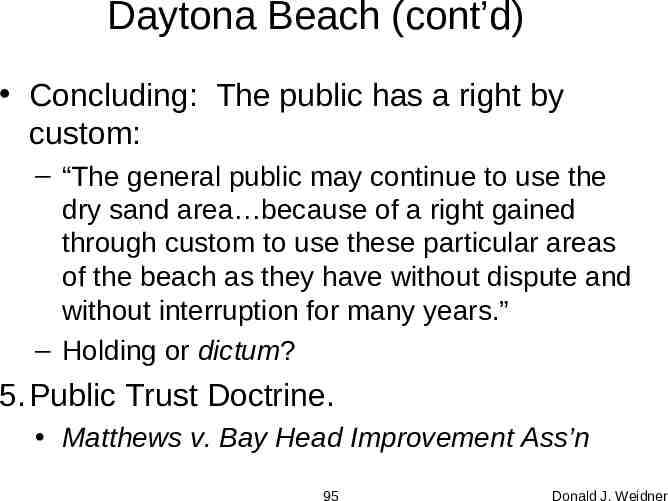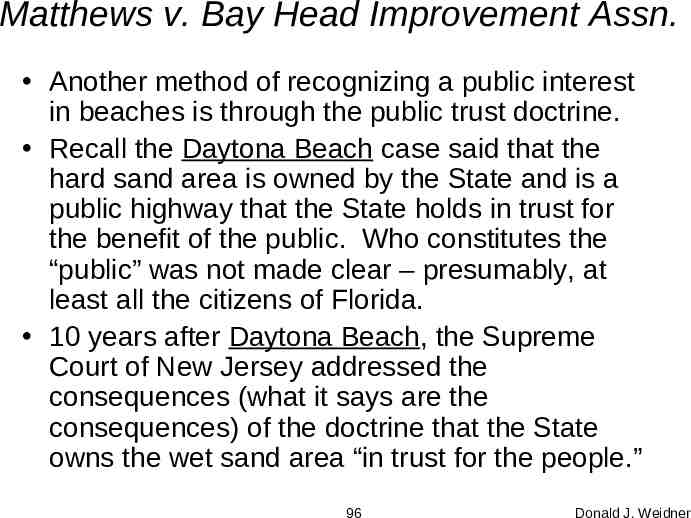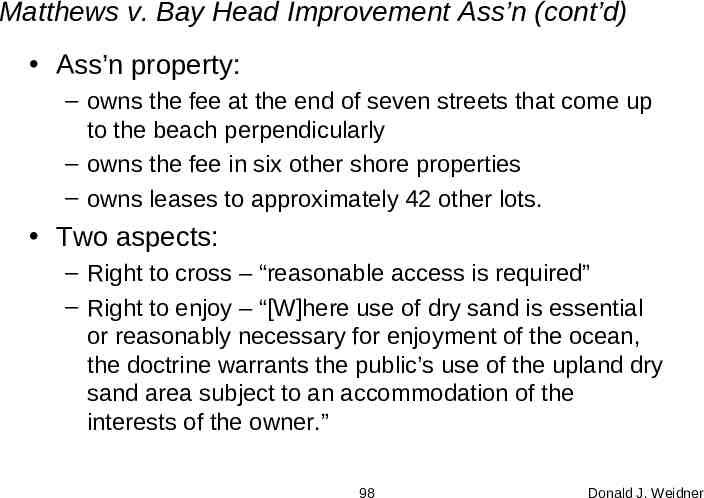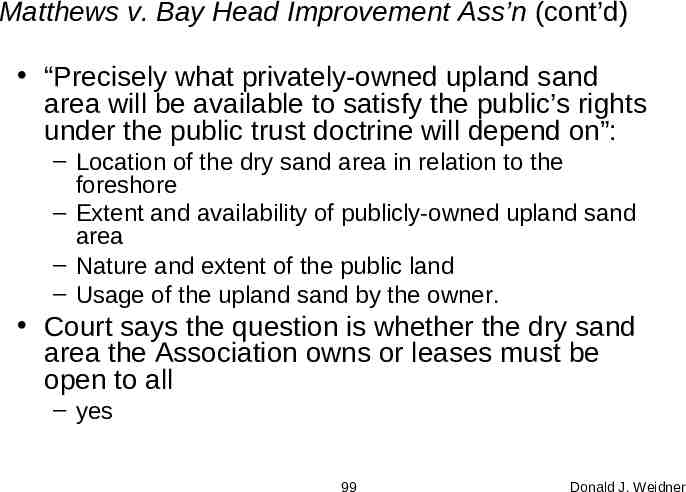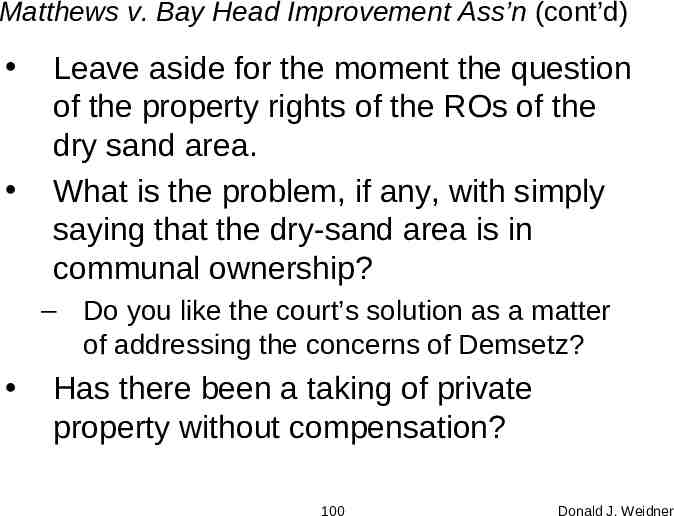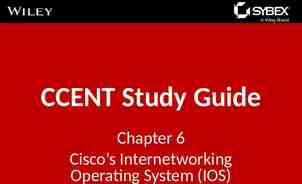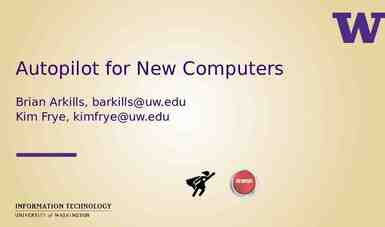ERNST v. CONDITT 6/18/60 LL Original Lease Lease provides: term, rent,
100 Slides485.00 KB
ERNST v. CONDITT 6/18/60 LL Original Lease Lease provides: term, rent, covenant by T to remove “all improvements above the ground.” Leased land 1 yr., 7 days [until June 30, 1961] T Enters, constructs and T encloses a race track (asphalt track, floodlights, fence) T to pay 4,200 per annum or 350/month, or 15% gross receipts “whichever is the larger amount” If gross receipts are larger, compiled quarterly, T is to pay them quarterly. No right to assign or sublet without T written approval, T to remain liable on the covenants in any event T promises to remove all improvements at end of lease T Enter negotiations for sale of business. Tee Tee wants longer lease. 1 Donald J. Weidner
8/4/60 LL Amendment to lease with express consent of LL to a particular “subletting.” Condition: original T “will remain personally liable” [new term until 7/31/62 (adding 13 mos.)] “Sublease” (no rent specified for the “sublease”) T All rent including % is to be paid monthly. T T “[I]n consideration of the promise [by Tee] to faithfully perform all conditions of the written lease, as amended, I [T] hereby sublet” [to Tee] “upon the understanding that I will individually remain liable . . . .” Accepts “the foregoing subletting” 2 Tee Tee Donald J. Weidner
LL Paid rent directly to LL for 3 mos. (Aug., Sept., Oct. 1960) Contacts for Nov. 1960 rent LL LL LL “I am not liable to you.” Made a payment the following June 1961. Never paid more thereafter and it is unclear whether Tee continued to operate the business after that; yet “remained in possession of the property until the expiration of the leasehold” 13 months after that. Seeks damages 1. Tee Tee Tee Tee Base rental unpaid on lease [not seeking any %] 2. Cost of removing the “improvements” [lessee’s cost under lease] 3 Donald J. Weidner
Ernst v. Conditt (cont’d) Before the “sublease,” there are two ways to rationalize the liability of the T to pay rent to the LL 1. Privity of contract--because lease has a contractual provision, promise or covenant to pay rent 2. Privity of estate—because the obligation to pay rent “inheres in the estate as a covenant real” There are two different approaches to distinguishing an assignment from a sublease 1. what the authors call the “formalistic” approach 2. the approach allegedly based upon intent 4 Donald J. Weidner
Second Look: FO Term of 5 years @ x/month T T FO When T signs lease, T is in privity of contract and liable on that basis. When T moves in, T comes in to privity of Estate and liable on that basis. Assigns (no assumption agreement) at the end of Year # 1 Nevertheless pays x/month for year Aee Aee At the end of Year # 2, Aee says: “I want out of this lease, what do I do?” What do you say? “Colorable” transfers to not divest an Aee of privity of estate. --Colorable is defined in terms of retention of an interest --Not in terms of intent to end liability 5 Donald J. Weidner
Ernst v. Conditt (cont’d) Opinion spends its time discussing whether the transferee is an assignee or a sublessee. The Transferee (Conditt) argues that the arrangement is a sublease because; 1. that is what the parties called it 2. T (Rogers) agreed to remain primarily liable Because T agreed to remain liable, Tee argues, T had an implied right of entry in the event of default by Tee This right of entry, Tee’s argument runs, was a reversionary interest “sufficient to satisfy the distinction between a sublease and an assignment of a lease.” 3. Tee never covenanted to pay rent 6 Donald J. Weidner
Ernst v. Conditt (cont’d) Court said the express agreement to remain liable did not create either or a right to re-enter or a reversion. – What if there had been an express reservation by OT of a right to re-enter in the event the Tee defaults? What are the arguments in favor of an assignment? – Do you distinguish situations on the basis of whether the primary lease and the alleged sublease are at the same rent? 7 Donald J. Weidner
Lease Assumption/Mortgage Assumption Lease Assumption LL LL LL Lease Tenant Approves assumption by assignee Tenant Assigns Assumes original lease obligation Deals directly Assignee Assignee 8 Donald J. Weidner
Mortgage Assumption Lender Mortgage Lender Approves assumption by buyer new owner Lender Borrower Owner Borrower Owner Deals directly 9 Sells Assumes original mortgage Buyer New Owner Buyer New Owner Donald J. Weidner
Original Tenant LL Q: Without more, is relieved of liability to Original Borrower ? Lender Q: What, then is the nature of the continuing liability? Secondary liability as quasi-surety. Original Tenant without first suing their transferee. 1. Means that can’t sue Original Borrower 2. If Original Tenant must pay LL 100 because assignee fails to, Original Tenant is subrogated to LL’s claim. In effect, by paying LL, OT buys the LL’s right to sue the assignee for 100. 3. But the Original Tenant/Borrower is discharged if there is a “material change in the terms of the tenancy” 10 Donald J. Weidner
Two statements are typically made to explain the discharge of the quasi-surety in the event of material change: 1. The obligations of a surety are strictly construed; and 2. The surety is discharge when the parties have increased the risk that the surety will be called upon to perform. Can a LL directly sue the T’s transferee if the transferee assumes the obligations of the original lease? – On what theory? – For rent that accrues after a subsequent reassignment? 11 Donald J. Weidner
HYPO Hypo: You, as a law-student, have a 3 year lease on an apartment. For personal reasons, you move out of the state. You ask your landlord if you can assign your lease to another law student to whose financial integrity you attest. – What would your expectations be in such a situation, and why? – What are the landlord’s expectations in such a situation? – What are your expectations if the landlord permits you to assign your lease? 12 Donald J. Weidner
Does the landlord get a windfall if he is allowed a cause of action against both the original lessee and the lessee’s assignee? Should the burden be on the landlord to make a new contract of liability with the original lessee, in light of the LL’s acquiescence in an assignment? Do you think a landlord would know of his right to hold the assigning lessee in the future? If so, does the superior knowledge indicate anything about a duty? If the landlord did not know he could have such a right, but was later so advised by counsel, should he still be able to raise it? 13 Donald J. Weidner
Do you think a vendor of real estate who has her vendee “assume and promise to pay” existing financing is aware that she remains personally liable on the mortgage? Is there a stronger case for an implied release if the lessor takes a new note from the assignee? In an area the courts say is analogous, that of mortgages, a new note would have been useless if the second purchaser had “assumed” the mortgage from the first purchaser, since the lender could recover on the theory of a third-party beneficiary contract. 14 Donald J. Weidner
In short, does the term “privity of estate” seem to be necessary in the case of an assuming assignee? The idea that there is a “covenant real,” a covenant “running with the land,” is that the convenant to pay rent somehow attaches to the person who holds the estate. – Why? – Because of corresponding benefit? – Is this apparently inconsistent with the idea that a duty to pay rent is “independent” of the landlord’s duty to repair, etc.? 15 Donald J. Weidner
Kendall v. Ernest Pestana, Inc. Lease involves 1,400 square feet of hangar space at a municipal airport. The lease provided that the lessee may not assign the lease or sublet the premises without the prior written consent of the lessor. The lease further provided that failure to obtain written consent rendered the lease voidable at the option of the lessor. The lessee requested consent to an assignment and the corporate lessor refused – The corporate lessor said it had an absolute right to refuse to consent to an assignment – The corporate lessor demanded increased rent “and other more onerous terms” as a condition of granting consent to the assignment – Even though the proposed assignees had a stronger financial statement and greater net worth than the current lessee and were willing to be bound by the provisions of the lease. 16 Donald J. Weidner
Kendall v. Ernest Pestana, Inc. (cont’d) The proposed assignees say: – The refusal is unreasonable and, as such, – Is an unlawful restraint on the freedom of alienation. The law favors free alienability of property. However, contractual restrictions on alienability are justified, said the court, to protect the reasonable interest of the lessor – in the identity of the possessor of the property – whose performance of the lease affects the rental income and – whose possession affects the value of the lessor’s reversion. Restraints on alienation are strictly construed – particularly if the restraint is a “forfeiture restraint” under which the lessor has the option to terminate the lease if an assignment is made without consent. 17 Donald J. Weidner
Kendall v. Ernest Pestana, Inc. (cont’d) Majority rule: the lessor may arbitrarily refuse to approve a proposed assignee – no matter how suitable the assignee appears to be and – no matter how unreasonable the lessor’s objection. – However, the lessor in some cases is found to have waived the right to refuse consent – And in other cases is held to be estopped from asserting the right to refuse consent. Growing minority rule: when a lease provides for assignment only with prior consent, the consent may be withheld only when the lessor has a commercially reasonable objection to the assignment – even in the absence of a provision that consent will not be unreasonably withheld 18 Donald J. Weidner
Kendall v. Ernest Pestana, Inc. (cont’d) Change is coming from the property side and from the contract side. From the property side, restraints on alienation are seen as less reasonable because 1. leasing arrangements are seen as less personal, and 2. site scarcity suggests the need for freer alienability. However, under the Second Restatement’s approach to the minority rule: 1. A clause absolutely prohibiting assignment; and 2. A clause granting absolute discretion over assignment to the lessor are both valid is if the clause is “a freely negotiated provision.” 19 Donald J. Weidner
Kendall v. Ernest Pestana, Inc. (cont’d) From the contract side, there has been an increased emphasis on the duty of good faith and fair dealing “inherent in every contract.” – See the analogous provisions in the UCC Here, the lessor retains the discretionary power to approve or disapprove an assignee proposed by the other party to the contract – this discretionary power should be exercised in accordance with commercially reasonable standards. – What if the language says that the lessor may act in an arbitrary manner? 20 Donald J. Weidner
Kendall v. Ernest Pestana, Inc. (cont’d) Note how the court sets aside the four justifications it identifies for the majority rule: 1. A lease is a conveyance and the landlord need to look to no one but the tenant. – Response: A duty to mitigate damages has changed that. 2. An approval clause is an unambiguous reservation of absolute discretion in the lessor over assignment. – – Response: Others have found it implicit that the lessor be required to state a reason. Further response: It is recognized today that the implication of a covenant of good faith and fair dealing is not judicial re-writing of a contract. 21 Donald J. Weidner
Kendall v. Ernest Pestana, Inc. (cont’d) Setting aside 4 justifications for the majority rule (cont’d) 3. Respect the doctrine of stare decisis because people have relied on the rule. – – Response: Everyone knew there was not unanimity on this rule and could see the change in the law. Further response: The change as part of the growing recognition of the contractual nature of leases. 4. Under these circumstances, the lessor has the right to capture the increased value of the property. – Response: We reject this assertion, which gives the lessor more than the benefit of the lessor’s bargain. 22 Donald J. Weidner
Kendall v. Ernest Pestana, Inc. (cont’d) Note the Pillsbury Madison amicus brief opposing a mandatory rule: – Amicus “requests that we make clear that, ‘whatever principle governs in the absence of express lease provisions, nothing bars the parties to commercial lease transactions from making their own arrangements respecting the allocation of appreciated rentals if there is a transfer of the leasehold.’” – “This principle we affirm.” Did the court’s opinion sound like it was declaring only a default rule? 23 Donald J. Weidner
Subsequent Developments 1989 California statute provides: “A restriction on transfer of a tenant’s interest in a lease may absolutely prohibit transfer.” In 1992, Carma upheld a “termination and recapture clause” in a negotiated commercial lease providing: – 1. T was to give LL written notice of any intended assignment or sublease and the proposed terms; – 2. LL could then terminate the lease with the T and, if the LL elected, could enter into a new lease with the intended assignee or sublessee; and – 3. T was not entitled to any profit realized by the LL as a result of the termination and reletting. 24 Donald J. Weidner
Preparing for Class/Exam/ Responding to Training Begin with the end in mind – – – – – Predominantly or exclusively multi-issue essay questions Covering a great deal of the course Under time pressure Instructor counts points Generally, weak exams make very few points—raise only a small number of the issues and arguments that could be raised Steps – Book brief – Brief on paper – Concept outline—with mini outline Compare after completion with study group – Take back exams under time pressure Compare after completion with study group 25 Donald J. Weidner
Private Land-Use Controls: The Law of Servitudes Modern servitudes can be broken into four types: 1. Easements 2. Covenants Covenants enforceable at law (“real covenants”) Covenants enforceable in equity (“equitable servitudes”) 3. Profits 4. Licenses 26 Donald J. Weidner
Five Types of Land Use Agreements 1. A is given the right to enter upon B’s land Text says is an easement Could also be a “mere” license 2. A is given the right to enter upon B’s land and remove something attached to the land Is a profit 3. A is given the right to enforce a restriction on the use of B’s land (see below) A’s right usually originates in a promise by B or B’s predecessor. The promise may be enforceable either at law as a real covenant or in equity as an equitable servitude. Could also be an easement. 27 Donald J. Weidner
Five Types of Use Arrangements (cont’d) 4. A is given the right to require B to perform some act on B’s land A’s right usually originates in a promise by B or B’s predecessor. The promise may be enforceable either at law as a real covenant or in equity as an equitable servitude. 5. A is given the right to require B to pay money for the upkeep of specific facilities A’s right usually originates in a promise by B or B’s predecessor. The promise may be enforceable either at law as a real covenant or in equity as an equitable servitude. 28 Donald J. Weidner
Affirmative and Negative Easements Affirmative Easements—allow the holder of the easement to do something on the land of another – Ex., an easement to use my neighbor’s boat ramp to launch and pull my boat Negative Easements—allow the holder of the easement to prevent an owner from doing something on his land – Ex., I can buy the promise of my neighbor that she will not open a beauty parlor on her property. Some easements are both positive and negative – Ex: the power company’s easement to string power lines over the front edge of my lot They can do something on my land I can not build on my land in a way that interferes with the lines 29 Donald J. Weidner
Creation of Easements Easements are interests in land within the meaning of the Statute of Frauds. – They generally require a writing, absent Easements may be created 1. 2. 3. 4. 5. fraud part performance estoppel By writing (grant) By implication By prescription By estoppel By custom We turn first to creation by a writing. 30 Donald J. Weidner
S Church Willard v. First Church of Christ T. STREET 19 Bldg. 20 Vacant Genevieve owned 2 lots across the street from the church of which she was a member. She permitted church to use the vacant lot (20) for parking during services. (She testified that she bought lot 20 to provide parking for the church.) G sold Lot 19 Peterson, who used bldg. as an office. Peterson Peterson Agreed to sell both lots to Willard (when he only owned Lot 19). Peterson put into escrow a deed conveying both lots “in fee simple” Sold lot 20 Recorded deed from Genevieve With deed provision (drafted by church’s attorney) Willard Realtor At some point, Peterson told Willard the church would want to use lot 20 for parking, but not about the deed restriction. Closing Paid Purchase Price and recorded the escrowed deeds executed by Peterson, which did not mention any easement. Subsequently learns of clause in Genevieve’s deed to Peterson and 31sues to quiet title. Willard Realtor Willard Realtor Donald J. Weidner
Willard v. First Church of Christ (cont’d) The language at issue: The Lot 2 deed Genevieve gave Vendee contained the provision at p. 786: – “subject to an easement for automobile parking during church hours for the benefit of the church on the property at the southwest corner of the intersection of Hilton Way and Francisco Boulevard . . . such easement to run with the land only so long as the property for whose benefit the easement is given is used for church purposes.” Is the attempted express creation of an easement in favor of the church good as against Vendee #2? How can you possibly bind Vendee #2, if Vendee #2 is a BFP without notice? 32 Donald J. Weidner
RECORDING ACTS Different types of acts. Generally, not mandatory to record but, the holder of an unrecorded interest can be cut off by other people. Who can be cut off by whom depends upon the jurisdiction. Jurisdictions vary according to: – – What type of interest you must record or run the risk of having cut off. Who can cut you off. The three most common rules are anyone who: 1. records first (in a pure “race” jurisdiction) 2. buys without notice (in a pure “notice” jurisdiction), or 3. both buys without notice and records first (in a “race-notice” jurisdiction). 33 Donald J. Weidner
Different information retrieval systems – Grantor-grantee – Tract Many of the deeds that are used will contain language drawn from different types of deeds: – Deed of grant – Covenant to stand seised – Deed of bargain and sale – Deed of lease and release Statutes typically contain a short-form deed. 34 Donald J. Weidner
Willard v. First Church of Christ (cont’d) What is a suit to quiet title? Consider again the clause in Genevieve’s deed to Peterson: – The conveyance is “subject to an easement for automobile parking during church hours for the benefit of the church [across the street] . . . such easement to run with the land only so long as the property for whose benefit the easement is given is used for church purposes.” Who drafted this language? – Was there a possibility of malpractice? – Had you been the church’s attorney, what language would you have drafted? in what document? 35 Donald J. Weidner
Willard v. First Church of Christ (cont’d) Did the lower court find intent to create an easement? What was the rule the lower court used to frustrate the intent of the grantors? – At common law, a grantor can not “reserve” an easement for the benefit of a stranger to the conveyance What is the difference between a reservation and an exception? – An exception prevents some part of the grantor’s estate from passing to the grantee An exception excludes from the grant some pre-existing servitude or interest. – A reservation allows a grantor’s whole estate to pass to the grantee, but revests a newly created interest in the grantor That is, a reservation creates a new servitude that did not exist before as an independent interest. 36 Donald J. Weidner
Willard v. First Church of Christ (cont’d) What is the reason behind the common law [mandatory] rule that prohibits reservations in favor of third parties? – According to the court? – According to the authors? What are the arguments against the common law rule? – – – – – – argument based on purpose of the rule? is intent defeated? does the grantee get a windfall? is the expectation of the third party defeated? is the desired outcome against public policy? is the resulting rule efficient? analogy to the requirement of a straw to create/sever a joint tenancy? 37 Donald J. Weidner
Willard v. First Church of Christ (cont’d) The rule has not been favored – – The highest courts of two states have eliminated the rule completely Other courts have been “repealing it piecemeal by evasion” 1. a reservation was treated as an exception – – this approach may only leave the interest in the grantor but one court has found that the grantor held the interest in trust for the benefit of the third party 2. a reservation was enforced when the third party was the grantor’s spouse Here, analogize to other intimate relationships? 3. subsequent grantees in the chain of title have been estopped from relying on the common law rule to challenge the reservation Here, estoppel because of record notice? 38 Donald J. Weidner
Easements Appurtenant An easement appurtenant benefits the owner of the easement in the use of land belonging to the owner. – EX. A, the owner of Lot A, has the right to use a road over Lot B, owned by B, to get to Lot A. Lot A is the dominant tenement (the benefited tenement). Lot B is the servient tenement (the burdened tenement). An easement appurtenant usually attaches to the dominant tenement and passes with it to successive owners. – (unless it is “personal”). 39 Donald J. Weidner
EASEMENTS IN GROSS An easement in gross does not benefit the owner of the easement in the use of land belonging to the owner; – rather, it benefits its owner without regard to the ownership of land. – Ex. Boat Owner BO has an easement at the coast to use a boatramp on X’s property. BO’s easement is a right that BO has independent of BO’s ownership of land. Was the easement in Willard appurtenant or in gross? – What would have happened if the congregation had sold the church structure to another congregation? – What would have happened if the congregation had moved to a new facility a half a block away? 40 Donald J. Weidner
Easements in Gross (cont’d) English common law: Easements in gross were non-assignable and non-inheritable: they died with the individual holder. USA: Some easements in gross are transferable whereas others are not transferable. – Courts are split on which are transferable and which are not. – Most commercial easements in gross are readily assignable; – Non-commercial easements may also be transferred if the grantor has evidenced the necessary intent, e.g., has used such words as “heirs and assigns.” 41 Donald J. Weidner
Regrant Theory Note text at 788: – Early “English courts held that an easement could not be reserved because it was a [new right] that could not be reserved because it did not issue out of the land granted. English courts ultimately found a way around this obstacle by inventing the regrant theory. They held that an easement “reserved” by the grantor was not a reservation at all (which would be void), but a regrant of an easement by the grantee to the grantor.” – But then, would not the Statute of Frauds require the deed to be signed by the grantee? Deed poll versus deed of indenture. 42 Donald J. Weidner
A Final Note on Willard Can you see any reason why a court might be slower to find the reservation of an easement in a deed than a grant of an easement in a deed? Hypo: A conveys to B Blackacre in fee simple absolute, “except A reserves an easement in A.” – Note: the reservation can be repugnant to the grant. – What is the duration of A’s easement? 43 Donald J. Weidner
Licenses A license is a permission given by a possessor of land that allows the licensee to do some act on the land that otherwise would be a trespass. The general rule is that a license is revocable – versus an easement, which is not revocable There are two exceptions in which a license is not revocable: 1. A license coupled with an interest (one that is incidental to the ownership of a chattel on the licensor’s land); and 2. A license that becomes irrevocable by operation of estoppel – This looks very much like an easement 44 Donald J. Weidner
DEEDS -- EASEMENTS Originally, fee estate passed by livery of seisin. Then, writings developed, deeds came to be used, but it was still the ceremony of livery of seisin that passed title. Incorporeal interests, such as easements, are non-possessory interests, – no livery of seisin was necessary, – they passed by deed of grant. 45 Donald J. Weidner
In 1535, the Statute of Uses brought about widespread alienation that did not require ceremonial delivery of seisin. – Covenant to Stand Seised for benefit of someone related to you by blood or marriage – Contract, or Deed, of Bargain and Sale for pecuniary consideration. – Deed of Lease and Release [of Reversion] was used to avoid the disclosure requirements of the Statute of Enrollments, which applied to the Covenant to Stand Seized and to the Bargain and Sale Deed. The Statute of Uses “executed” the arrangement in each case, the promisor being held to be a trustee for the [grantee], that is, being seized to the use of the [grantee]. – In other words, the purchaser acquired seisin and possession just as if there had been livery of seisin. 46 Donald J. Weidner
DEEDS IN USE TODAY In 1677, the Statute of Frauds was enacted, requiring a writing to convey an interest in land and abolishing livery of seisin. Three types of deeds used in U.S.A. today: 1. General warranty deed, which warrants title against all defects in title, whether they arose – before the grantor took title or – after the grantor took title. 2. Special warranty deed, which warrants only against the grantor’s acts – not against the acts of others. – Ex., the grantor under a special warranty deed is not liable for a mortgage executed by the grantor’s predecessor in interest. 3. Quit claim deed, which contains no warranties of any kind. – It simply conveys whatever title the grantor has, if any. 47 Donald J. Weidner
Six “Usual” Covenants A. Three “Present” Covenants – phrased in the present tense – broken or not when the deed is delivered 1. Covenant of Seisin. The grantor warrants the grantor owns the estate the grantor purports to convey. 2. Covenant of Right to Convey. The grantor warrants that the grantor has the right to convey the estate. 3. Covenant Against Encumbrances. The grantor warrants that there are no encumbrances on the property, such as – – – mortgages or other liens easements covenants 48 Donald J. Weidner
Six “Usual” Covenants (cont’d) B. Three “Future” Covenants -- promise the grantor will act in the future -- are not breached until some future harm 1. Covenant of General Warranty. The Grantor warrants that the grantor will defend against lawful claims and will compensate the grantee for any loss caused by the assertion of superior title. 2. Covenant of Quiet Enjoyment. The Grantor asserts that the possession of the grantee will not be disturbed by the assertion of superior title. As a practical matter, the same as #1. 3. Covenant of Further Assurances. The Grantor promises to execute any other documents required to perfect the title conveyed. 49 Donald J. Weidner
CERCLA “The Comprehensive Environmental Response, Compensation, and Liability Act (“CERCLA”) imposes strict liability for cleanup costs of a hazardous waste site upon – any current owner or operator of a site containing hazardous waste, – any prior owner or operator of the site at the time it was contaminated, – any generator of hazardous waste, and – transporters of hazardous substances.” 50 Donald J. Weidner
CERCLA (cont’d) In 1986, Congress added an “innocent landowner” defense. – available to one who “buys the property after the site is contaminated and does not know and has no reason to know that any hazardous substance has been released on the property.” – the buyer has a duty to make “all appropriate inquiry” into previous ownership and uses Sellers and brokers may have a duty to disclose off-site hazardous waste conditions 51 Donald J. Weidner
Creation of Easements Encore Easements may be created by: 1.Grant 2.Implication From necessity (on severance) From existing use (on severance) Implied dedication 3.Prescription 4.Estoppel 5.Custom 52 Donald J. Weidner
HOLBROOK v. TAYLOR Holbrook involves an action to establish a right to use a road, 12’ X 250’, over the unenclosed, hilly woodlands of another. The theories: – Easement by prescription – Easement by estoppel The claimant’s apparent starting point: the road had been used by persons other than the fee owner for a very long time. 53 Donald J. Weidner
Holbrook v. Taylor (cont’d) 1942: RO purchases fee 1944: RO gives permission for a haul road to be cut to move coal from a newly opened mine. – Royalty was paid for road use. 1949: Mine closed. 1957: RO constructs tenant house; tenants use the road with permission. 1961: RO’s tenant house burns. 1964: Neighbor buys adjoining 3-acre site. 1965: Neighbor builds residence costing 25,000 on the 3-acre site. – Workers were permitted to use the road to get to the building site. – RO apparently gave oral permission “to use and repair the roadway.” – Neighbor spent 100 on road (the strip was worth 500) There is no other location over which a roadway could reasonably be built to provide an outlet for the Neighbors. 54 Donald J. Weidner
Holbrook v. Taylor (cont’d) Why does the court say there is no prescriptive easement here? Restatement on prescriptive easements: – “An easement is created by such use of land, for the period of prescription, as would be privileged if an easement existed, provided the use is adverse, and for the period of prescription, continuous and uninterrupted.” Give meaning to 1. 2. 3. 4. adverse use, which is continuous and uninterrupted for the period of prescription. 55 Donald J. Weidner
Holbrook v. Taylor (cont’d) Would you find an easement by estoppel here? – Why? Court: “the evidence is conflicting as to whether the use of the road subsequent to 1965 was by permission or under claim of right.” – The RO said permission – The Neighbor (easement claimant) said no permission – What do you make of the absence of a dispute for five years--until 1970? – Court said there was “tacit approval” if not “actual consent” From the Latin tacitus, meaning silent Also meaning implied or inferred 56 Donald J. Weidner
Holbrook v. Taylor (cont’d) For how long does the easement continue? Suppose the successful claimant’s house burns down the next year. May the claimant rebuild? – “for so long a time as its nature calls for” – Or, the Restatement of Property approach: “to the extent necessary [for the licensee] to realize upon his expenditures.” – See also Restatement Contracts, 2d, 90(1): “A promise which the promisor should reasonably expect to induce action or forbearance . . . and which does induce such action or forbearance is binding if injustice can be avoided only by enforcement of the promise. The remedy granted for breach may be limited as justice requires.” 57 Donald J. Weidner
Holbrook v. Taylor (cont’d) If the easement is “found,” should RO get damages? – Assume the entitlement was worth 500 to RO (there was evidence that RO tried to get Neighbor to pay 500 for the right) – Assume the entitlement was worth 25,000 to Neighbor (the amount Neighbor invested in the house) Are there 24,500 possible “gains from trade?” Giving FO damages gives all the gains from trade to Neighbor. If FO is given the entitlement (gets the injunction), the FO might behave strategically – There is a bilateral monopoly situation – It is possible that the entitlement might not be transferred to Neighbor and society would suffer a loss 58 Donald J. Weidner
Holbrook v. Taylor (cont’d) To avoid societal lost or for some other reason, should you allocate the entitlement to the party who values it the most (in this case, Neighbor)? – Neighbor says it is efficient to 1. allocate it to me and 2. deny damages. – Let RO serve the function of the cheapest cost avoider and tolerate my use. – Save us the cost of litigation over damages 59 Donald J. Weidner
VAN SANDT v. ROYSTER FO (plaintiff) finds 6 inches of sewage in his basement and tells his neighbors to stop flushing. The factual background. Common Grantor owned all 3 lots in question, in an east-west line, and occupied the easternmost lot. In 1903-04, the City ran a sewer pipe in the street just west of the westernmost of the 3 lots. Common Grantor then ran a “private lateral drain” from her easternmost lot, under the other two lots, out to the sewer in the street to the west. At beginning of 1904, CG conveyed the westernmost lot [lot 19] “by general warranty deed with the usual covenants against encumbrances, and containing no exceptions or reservations.” The 1904 grantee knew of the Common Grantor’s private sewer and hooked into it. There were subsequent mesne conveyances of lot 19 to the FO (plaintiff). 60 Donald J. Weidner
Van Sandt v. Royster Tenth Street Highland Avenue Lot 19 Lot 20 1904 Bailey to Jones, who built house and connected to sewer 1904 Bailey to Murphy, who built house and connected to sewer Lot 4 Lateral sewer constructed in early 1904 by Bailey City Sewer 61 Donald J. Weidner
Van Sandt v. Royster (cont’d) The two large issues: 1. Was an easement created? In this case, the claimants (Neighbors) argued: – – Easement by implication from an existing use (from a “quasi easement”) Easement by prescription (court never reaches this issue) 2. If an easement was created, does Van Sandt, a subsequent grantee, take free of it because he is a BFP without notice of its existence? – Stated differently, should the easement cut off because it was not – – recorded? apparent? » Court says benefit of a quasi easement passes if it is “of an apparent, continuous and necessary character.” 62 Donald J. Weidner
Van Sandt v. Royster (cont’d) Implied grants versus implied reservations – some treat the two the same – some make it harder to establish an implied reservation disliking the grantor being permitted to transfer less than her written instrument promises disliking a clash with the recording acts some say there must be “strict necessity” before there will be an implied reservation of an easement in favor of the grantor, even when there was an existing “quasi easement” at the time of the grant – this has been applied to existing drains and sewers 63 Donald J. Weidner
Van Sandt v. Royster (cont’d) Van Sandt says that , both in the case of a grant and in the case of a reservation, an easement created by implication arises as an inference of the intention of the parties to a conveyance – inference from the circumstances rather than from the language of the conveyance 64 Donald J. Weidner
Van Sandt v. Royster (cont’d) Restatement factors to determine whether the circumstances of a conveyance “imply an easement” or profit: 1. 2. 3. 4. 5. Whether the claimant is the grantor or the grantee The terms of the conveyance The consideration given for the conveyance Whether the claim is for a simultaneous grantee The extent of the necessity of the easement to the claimant 6. Whether reciprocal benefits result to grantor and grantee 7. The manner in which the land was used prior to the conveyance, and 8. The extent to which the manner of prior use was or might have been known to the parties. 65 Donald J. Weidner
Van Sandt v. Royster (cont’d) With respect to the creation of an easement, must the prior used have been known by the parties? – Restatement: must have been known “or, at least, have been within the possibility of their knowledge.” Must the use or the easement have been apparent? – what is the difference between “visible” and “apparent”? “appearance and visibility are not synonymous.” – does that mean it is sufficient that it is visible to “the mind’s eye”? Court says the purchaser was “charged with notice” 66 Donald J. Weidner
Van Sandt v. Royster (cont’d) Is it fictional to presume the intent of the parties to a grant? – See Restatement, Section 28, Illustration 10: Easement is created by implication even though neither the grantor nor the grantee know of it “each had reasonable opportunity to learn of such facts.” Given that an easement was created 34 years earlier, is the RO of the alleged servient tenement bound by it if he purchased with no knowledge of it? – Want to permit reliance on the record – On the other hand, not by people who had other notice Knowledge versus notice 67 Donald J. Weidner
Van Sandt v. Royster (cont’d) How would you decide the case and why? How would you put liability on the cheapest cost avoider in this case? Suppose Bailey is still alive. Van Sandt loses here when the court holds that an easement existed and Van Sandt is still bound by it. Could Van Sandt sue Bailey on her general warranty deed? – On the covenant against encumbrances? Breached or not on the conveyance years ago, such that the statute of limitations to sue on the breach has passed? – On the covenant of general warranty? Bailey can argue that if the easement is implied on the basis of the parties’ intent that it continue, the easement should also be held to be an implied exception to the warranty. 68 Donald J. Weidner
Othen v. Rosier Involves claim of easements by – necessity and – prescription Othen (claimant—alleged owner of the dominant estate) had been using a road through RO’s two parcels for 40 years. Alleged servient owner (Rosiers) made all the repairs to the road over the years. No one else asserted either a right or an obligation to repair it. RO’s land started flooding. To hold the waters back, RO built a levee along the south side of the road, which caused the road to become very muddy and impossible except by horseback. Claimant Othen sues for: – injunction (take down the levee) and – damages 69 Donald J. Weidner
Othen v. Rosier 100 acres Rosier 53 acres Othen Belt Line Road Rosier’s House Othen’s House Lane 60 acres Othen 16.31 acres Rosier 100 acres conveyed by Hill (the common grantor) in 1896. 60 acres conveyed by Hill in 1897. 53 acres and 16.31 acres conveyed by Hill in 1899. 70 Donald J. Weidner
Othen v. Rosier (cont’d) Claimant’s first argument: That there has been an implied reservation of an easement by necessity – What is the theory of this claim? Public policy against landlocked parcels? Presumed intent? Anything else? – Consider the court’s statement: “[T]he mere fact that the claimant’s land is completely surrounded by the land of another does not, of itself, give the former a way of necessity over the land of the latter, where there is not privity of ownership.” – Why was the claimant, who had used the road for decades, denied an implied reservation of an easement by necessity? Back 50 years but not 54 years? 71 Donald J. Weidner
Othen v. Rosier (cont’d) Claimant’s second argument: That an easement has been established by prescription – What is the theory of the claim of an easement by prescription? – Recall the Restatement says that an easement arises by use that is 1. 2. 3. 4. Adverse Continuous Uninterrupted For the period of prescription What is the general rule about the requirement that the use be adverse? – Analogous to the requirement of adversity to establish title by adverse possession. – “If the enjoyment is consistent with the right of the owner of the tenement, it confers no right in opposition to such ownership.” 72 Donald J. Weidner
Othen v. Rosier (cont’d) Further points about the requirement of adversity: – Court: when the owner of the fee is using the land for the same purposes as the person who claims the prescriptive easement, the use is presumed to be permissive. Why? – Court: several factors also indicate permissive use The FO of the 100 acres erected a gate in 1906, which indicates that the FO and his successors were controlling passage through the land and permitting others to use it. The claimant’s use of the land was not exclusive, it did not interfere with the use of the FO and thus was not adverse. The FO, not the person claiming the prescriptive easement, kept the road in repair. 73 Donald J. Weidner
Othen v. Rosier (cont’d) Consider the following: “The foundation of prescriptive title is the presumed grant of the party whose rights are adversely affected; but where it appears that the enjoyment has existed by the consent or license of such party, no presumption of grant can be made.” – Must a plaintiff allege her own wrongdoing to win? 74 Donald J. Weidner
Othen v. Rosier (cont’d) The lost grant theory draws a confusing distinction between – acquiescence and – permission. To establish a prescriptive easement in a jurisdiction following the logic of the fiction of a lost grant, the claimant must show – that the use was not permissive and – that the owner acquiesced (did not object). I had no permission and the owner never objected – Analogy to adverse possession? 75 Donald J. Weidner
Othen v. Rosier (cont’d) Is the analogy to adverse possession appropriate? – There, must show exclusive possession for the statutory period – Why should the exclusivity requirement also bar a claim that is merely to a nonexclusive easement? – The majority requires exclusivity for an easement by prescription, but defines it differently in this context: “Exclusivity does not require a showing that only the claimant made use of the way, but that the claimant’s right to use the land does not depend upon a like right in others.” What is an alternative analogy to be used in Othen? – Common driveway cases in which a driveway is ½ on the land of each adversity on the part of each to the other has been presumed 76 Donald J. Weidner
Othen v. Rosier (cont’d) What about the requirement that the use be uninterrupted for the prescriptive period? – What if the FO writes a letter: “You have no right to use this road: stay off my property.” – What would the analogy to adverse possession say? – What would the logic of the lost grant say? Recall: “To secure a prescriptive easement under a lost grant theory the claimant must show that the use was not permissive and also that the owner acquiesced (did not object).” – In a jurisdiction analogizing fully to the law of adverse possession, rather than following the logic of the fiction of a lost grant, the owner must effectively interrupt or stop the adverse use to prevent a prescriptive easement from being acquired. 77 Donald J. Weidner
Othen v. Rosier (cont’d) An easement implied to continue an existing use (a quasi easement—the theory of Van Sandt) was never mentioned. – Some: the extent of the necessity is simply one factor to be considered Note: If strict necessity is required, then the fact that defeated the easement by necessity would defeat the easement implied to continue a quasi-easement. If lower standard of necessity is required, then an implied easement might be found if an apparent road had existed over the 100 acres in 1896. – The use can be invisible and still bind third parties 78 Donald J. Weidner
Othen v. Rosier (cont’d) An easement by estoppel was not argued either, even though – Holbrook v. Taylor ( 25,000 house case), which said reasonable reliance made the license irrevocable. And, the case was proven by acquiescence “if not affirmative consent” – But, in some states, need a writing. No conveyance of an interest in land simply because a judge thinks it is fair to find one. 79 Donald J. Weidner
Beach Access Two aspects of beach-access-for-the-public problem: – – Acquire an interest in the public in the dry sand area Acquire rights of way in the public across uplands so they can get to the dry sand area. Two general solutions: – – Create Beach Parks Create Easements Purchase them Require them through subdivision exactions Litigate to establish easements based on public use. 1. 2. 3. 4. 5. Adverse possession Implied dedication Prescriptive easement Custom Public trust 80 Donald J. Weidner
Beach Access (cont’d) Consider: 1. Adverse possession – No exclusive possession – Othen said exclusivity in this context means that the claimant’s rights to not depend on the rights of others No tacking of successive users because there is no privity between them 2. Implied Dedication – – Most say implied dedication is a question of intent (although the finding often appears fictional) Some use the theory of implied dedication to establish public easements, especially if the state seems to accept that there is a public easement by maintaining the land for the use by the public. Implied dedication may be used as a substitute for the theory of prescription Historically, only public roadways were held dedicated by public use alone 81 Donald J. Weidner
Beach Access (cont’d) 3. Easement by Prescription – Reasons largely unsuccessful: Public cannot be sued in trespass or ejectment – Public cannot receive a grant Easement asserted is in gross, personal, nonassignable Most courts presume the use is permissive – – Although some established prescriptive easements in the public for roads and highways and the burden of proving adverse use cannot be met Some say there is no presumption as to the character of use Must be so used [parcel by parcel] However: “In most states, a public prescriptive easement can be obtained by long continuous use by the public under a claim of right.” “ The fee owner must be put on notice, by the kind and extent of use, that an adverse right is being claimed by the general public, and not by individuals.” 82 Donald J. Weidner
Beach Access (cont’d) Note statutory intervention on the issue of “permission.” For example, in reaction to some case law, California passed a statute stating that FO may prevent implied dedication either by annually posting permission or by recording permission. 4. Custom 83 Donald J. Weidner
State ex rel Thornton v. Hay “State Highway Commission” represented the rights of the public in this classic beach access case. FO fenced in a portion of a parcel owned in fee, in the dry sand area, thus denying beach access and use to the public over the FO’s land. – FO asserts an unencumbered fee, as shown in the public records in the county court house. Majority concludes the “record title” is encumbered by a superior right in the public “to go upon and enjoy the land for recreational purposes.” 84 Donald J. Weidner
Mean low tide State Owned “Wet Sand” Area Mean high tide Dry sand area “subject to private ownership” Vegetation Line Upland 85 Donald J. Weidner
State ex rel Thornton v. Hay (cont’d) Court “paraphrases” Blackstone to state the 7 requisites for an enforceable custom: 1. 2. 3. 4. 5. 6. 7. Must be ancient (at least “long and general” use) Must be exercised without “interruption caused by anyone possessing a paramount right.” Must be peaceable and free from dispute (court says this follows from evidence on #2) Must be reasonable (court says police have always interrupted unreasonable use) Must be certain (court says (a) visible boundaries of dry sand area and (b) character of the land –limit (a) space and (b) use to recreational use in connection with foreshore. Must be obligatory Must be consistent with other customs and laws Result: there is a public easement along the entire coast of Oregon by virtue of the law of custom. 86 Donald J. Weidner
Taking? What if the legislature enacted a statute declaring public easements on the dry sand areas and also easements of access to those areas? – Maine case, after Hay, said foul Is there a constitutional problem? 5th Amendment ratified in 1791: “No person shall be deprived of . . . property, without due process of law; nor shall private property be taken for public use, without just compensation.” 14th Amendment was adopted in 1868: “No state shall . . . deprive any person of . . . property, without due process of law . . . .” – The courts have said that a “just compensation” clause is incorporated interstitially in the 14th Amendment. If the legislature is constrained, are the courts also constrained? 87 Donald J. Weidner
City of Daytona Beach v. Tona-Rama, Inc. Δ owned waterfront property in Daytona Beach, FL for more than 65 years and operated thereon a pier extending 1,050 feet into the Atlantic as a recreation center and tourist attraction. – Δ provided such attractions as fishing space, helicopter flights, dances and skylift. “The tract of land upon which the pier begins extends 102 feet north and south along the ocean front and approximately 150 feet landward of the mean high water mark. This area of approximately 15,300 square feet is an area of dry sand .” 88 Donald J. Weidner
City of Daytona Beach (cont’d) Δ secured a permit for and constructed a 125,000 observation tower with circular foundation 17 feet in diameter – tower is 4 feet in diameter. – “It occupies 225-230 square feet of the 15,300 square feet of land to which Δ holds record title.” – The observation tower can only be entered from the pier.” Oceanward and easterly of the dry sand area is the foreshore, that is, the hard or wet sand area. operated an observation tower near the site of the pier and protested the issuance of the permit. 89 Donald J. Weidner
Daytona Beach v. Tona-Rama (cont’d) sued to enjoin the construction of the new observation tower alleging, inter alia, “that by continuous use of the property for more than 20 years, the public had acquired an exclusive prescriptive right to the use of the land of the Δ.” Summary judgment for Π: Defendant ordered to take the tower down within 90 days. – Affirmed on appeal. – Certified to Florida Supreme Court as a question of great public interest. Florida Supreme Court said that there were not sufficient facts to support a summary judgment to deprive a FO of a meaningful use of a large portion of the land – for which he paid, – which he occupies in part, and – for which he pays taxes. 90 Donald J. Weidner
Daytona Beach v. Tona-Rama (Cont’d) Court cited a 1939 personal injury case by a beacher who was hit by an automobile on the wet sand area. – The 1939 case said that even though Florida Statute had declared the wet sand area a public highway, “the right of the public to use the beach for bathing and recreational purposes is superior to that of the motorists driving automobiles thereon.” – Noting that the state owns the wet sand area “in trust” for the people. More anon on lands held in public trust 91 Donald J. Weidner
Daytona Beach v. Tona-Rama (cont’d) First Possibility: “It is possible for the public to acquire an easement in the beaches of the State by the finding of a prescriptive right to the beach land – – – – Citing Florida cases that said so, but that failed to find a prescriptive easement “because of the absence of an adverse nature in the public’s use of private beach land.” Problem # 1. “[I]n either prescription or adverse possession, the use or possession is presumed to be in subordination to the title of the true owner, and with his permission, and the burden is on the claimant to prove that either the use or the possession is adverse.” Problem # 2. Even if public did have a prescriptive easement in the dry sand area, building the tower was not inconsistent with the public’s use of the recreational area. 92 Donald J. Weidner
Daytona Beach v. Tona-Rama (cont’d) Second Possibility: “If the recreational use of the sandy area adjacent to mean high tide has been ancient, reasonable, without interruption and free from dispute, such use, as a matter of custom, should not be interfered with by the owner.” – However: the owner may make any use of his property which is consistent with such public use and not calculated to interfere with the exercise of the right of the public to enjoy the dry sand area as a recreational adjunct of the wet sand or foreshore area.” 93 Donald J. Weidner
Daytona Beach (cont’d) Dictum. It is possible to establish a prescriptive easement in the public. Holding. No prescriptive easement is established here because there is no showing of adversity. Dictum: The use “is presumed to be with permission” – – “The burden is on the claimant to prove that the use or permission is adverse.” Dictum: We shall not doom all meaningful use of the property by the owner-taxpayer. 94 Donald J. Weidner
Daytona Beach (cont’d) Concluding: The public has a right by custom: – “The general public may continue to use the dry sand area because of a right gained through custom to use these particular areas of the beach as they have without dispute and without interruption for many years.” – Holding or dictum? 5. Public Trust Doctrine. Matthews v. Bay Head Improvement Ass’n 95 Donald J. Weidner
Matthews v. Bay Head Improvement Assn. Another method of recognizing a public interest in beaches is through the public trust doctrine. Recall the Daytona Beach case said that the hard sand area is owned by the State and is a public highway that the State holds in trust for the benefit of the public. Who constitutes the “public” was not made clear – presumably, at least all the citizens of Florida. 10 years after Daytona Beach, the Supreme Court of New Jersey addressed the consequences (what it says are the consequences) of the doctrine that the State owns the wet sand area “in trust for the people.” 96 Donald J. Weidner
Matthews v. Bay Head Improvement Ass’n (cont’d) An earlier New Jersey case, Avon, had held that “the public trust applied to the municipallyowned dry sand beach immediately landward of the high water mark.” The major issue in this case is whether, ancillary to the public’s right to use the tidal lands, the public has a right 1. to gain access through and 2. to use the dry sand area not owned by a municipality but owned by a quasi public body. 97 Donald J. Weidner
Matthews v. Bay Head Improvement Ass’n (cont’d) Ass’n property: – owns the fee at the end of seven streets that come up to the beach perpendicularly – owns the fee in six other shore properties – owns leases to approximately 42 other lots. Two aspects: – Right to cross – “reasonable access is required” – Right to enjoy – “[W]here use of dry sand is essential or reasonably necessary for enjoyment of the ocean, the doctrine warrants the public’s use of the upland dry sand area subject to an accommodation of the interests of the owner.” 98 Donald J. Weidner
Matthews v. Bay Head Improvement Ass’n (cont’d) “Precisely what privately-owned upland sand area will be available to satisfy the public’s rights under the public trust doctrine will depend on”: – Location of the dry sand area in relation to the foreshore – Extent and availability of publicly-owned upland sand area – Nature and extent of the public land – Usage of the upland sand by the owner. Court says the question is whether the dry sand area the Association owns or leases must be open to all – yes 99 Donald J. Weidner
Matthews v. Bay Head Improvement Ass’n (cont’d) Leave aside for the moment the question of the property rights of the ROs of the dry sand area. What is the problem, if any, with simply saying that the dry-sand area is in communal ownership? – Do you like the court’s solution as a matter of addressing the concerns of Demsetz? Has there been a taking of private property without compensation? 100 Donald J. Weidner


























































































